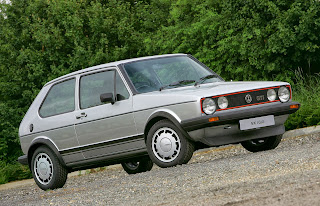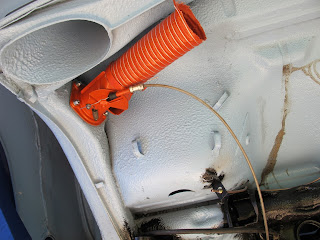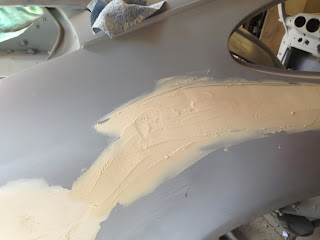 |
| Quick enough, and comfy |
This summer, the 7th generation Golf Gti was released. I've not tried one yet (I don't trust myself) but press reports suggest that once again VW have managed to create a car that meets all the expectations of a demanding market; sensible fuel consumption, low emissions, lots of safety equipment, a dose of prestige, high levels of refinement, driver friendly DSG transmission & electric steering, electronically adjustable dynamics, and the connectivity demanded by the iPhone generation. At the same time, poke it with a sharp stick and there's plenty of performance, more than the small power increase would suggest as the adoption of VAG's new all-things-to-all-men MQB platform comes with a big weight saving over its predecessor.
Performance and comfort; perfect for a middle aged family man like me with the odd ache and twinge, but who still likes to put the pedal to the floor occasionally (when the conditions are suitable and all within the legal limits m'lud).
It occurs to me that the Gti's development over three and a half decades has matched my own driving career.
In 1979 VW launched the Gti version of the Mk1 Golf in right hand drive form. Odd that we don't notice seminal moments until later on, but for UK enthusiasts it was the start of the hot-hatch revolution that came to define the next ten or so years. That Gti weighed a mere 850kgs, and had a wonderfully responsive 1600cc engine, great chassis and terrible brakes. It was a middle-class hooligan. The year was significant for other reasons too; it marked the beginning of near two decades of Conservative rule, there was a Muslim inspired revolution in Iran, the IRA assassinated Lord Mountbatten, Sid Viscous died, and at the tender age of 18 I entered the world of work - complete with brand spanking new driving licence.
 |
| Mk1 Golf Gti; perky and good with Pimms |
Sadly, a Gti was way out of reach, but within my social sphere there were a few. A generous father bought one for his daughter - a bright young thing who made something approximating a living catering for smart dinner parties. From time to time I'd find myself squeezed into the back, dawn in the sky, as we returned home from a ball or party, balancing glasses of liberated Pimms or Champagne on our knees and the front seat passenger on steering duty while our driver took another sip. Possibly the bright young thing and I enjoyed a moment, possibly not, but I'll always remember her Lhasa Green Gti. My own car, a tired MGB, felt vintage by contrast, I remember an indicated 100mph requiring all three lanes of the M3 when I tried it one quiet winter's evening.
 |
| The Mk2 16v; 139bhp has got to be enough, right? |
By the middle of the decade we'd all grown up a bit. In 1983 the mk2 Golf hit the UK's shores. Like me, it too was a bit heavier, a bit more serious, and a bit more sensible. At the time I was working in London, taking the first steps in a career in marketing. I lived in Battersea and had little money left over for expensive cars after rent, beer, and food bills. Black, blue, red or dark green Gti's were ubiquitous in my slice of south London, sitting in summer traffic jams with Everything But the Girl, Aztec Camera or Duran Duran spilling out from the stereo. The VW dealer in Sloane Square must have had a very, very good decade.
Occasionally a friend borrowed cars for the weekend from the Surrey VW garage where he worked. I remember one Sunday afternoon heading west along the A4 towards Marlborough in a brand new 16v Golf, and being given the opportunity to get behind the wheel. I thought that it (with a full 139bhp) was as fast as any road car needed to be.
Another time my brother and I hired one for a few days as a treat for the old man's birthday (we couldn't manage the hire fees of anything more interesting). It had the desired effect though, that Golf re-lit the blue touch paper of our father's long dormant motoring interest, which had long been long subsumed by the need to pay school fees. Not long after he bought the first of his Porsche 924s.
VW's next effort arrived in the UK in 1993. Like me, it had gone rather soft and pudgy. The Mk3 was produced in the face of a major recession and huge increases in insurance costs for anything that might possiblty be labelled as a performance hatchback. In this hangover from the party decade of the 80's, perhaps the third generation Golf did make sense, but the Gti, especially with the old 8 valve engine, was a long, long way from the perky Gti's of old.
I bought one.
 |
| Middle aged, overweight, dull. The Golf I had was pretty good though. |
It was a perfect family runaround now that I had one toddler and another baby on the way, and made a practical foil to the Caterhams and 911s that occupied the other half of my double garage. My wife liked that it didn't show complete surrender in the face of demands of motherhood, and while the torquey old 2 litre engine was no ball of fire, it could be persuaded to make decent progress. Ours was dark red, with the air-conditioning system that we suddenly discovered we couldn't possibly live without.
Later on, two more Mark 3 Golfs entered the fleet; one a lovely low mileage VR6 that was supposed to be a winter hack, but turned out to be too good, the second a hybrid Mark 3 1/2 cabriolet that provided summer fun for a couple of seasons.
 |
| It might look dark red, but it was purple (with a matching leather interior) |
 |
| The Mk3.5 cabriolet; for West Sussex summers |
By the end of the 90's I was holding down a consultancy job in a marketing services company North of London. I had clients in Yorkshire and Bristol, and as a result needed a comfortable, economical car, that would present a professional image in client car-parks but could also provide family wheels at the weekend.
Enter the fourth generation of Golfs; my own Gt Tdi was one of the first cars that tried to combine Gti performance with the 50mpg a diesel promised. The quantum leap in interior quality the Mark 4 represented perfectly matched my new found executive status and grown-up tastes. I loved it. In hindsight, everything that made the Mk1 such a brilliant drive had long been developed out of the Golf.
 |
| Red 'i', red 'd'. Middle manager wheels; the Mark 4 with the 115bhp version of the Tdi engine |
Enter my mk5 Gti, complete with a DSG gearbox. Its been perfect; suitable steel wheels and winter tyres proved to be a revelation when the snows came, and other than replacing the dampers when they became tired, I've not had to lay a spanner on it in 40,000 miles and 3 years.
 |
| Inoffensive all-year round mobility |
Its difficult to build a strong case for replacing the car at the moment. Depreciation at 8 years old is now low, mileage is a reasonable 70,000, and the magazines (CAR was the latest) are fingering it for future classic status. Perhaps a growing list of mechanical woes will force an update. If that happens, I wonder what will replace it, 6 or 7?
SS7














































